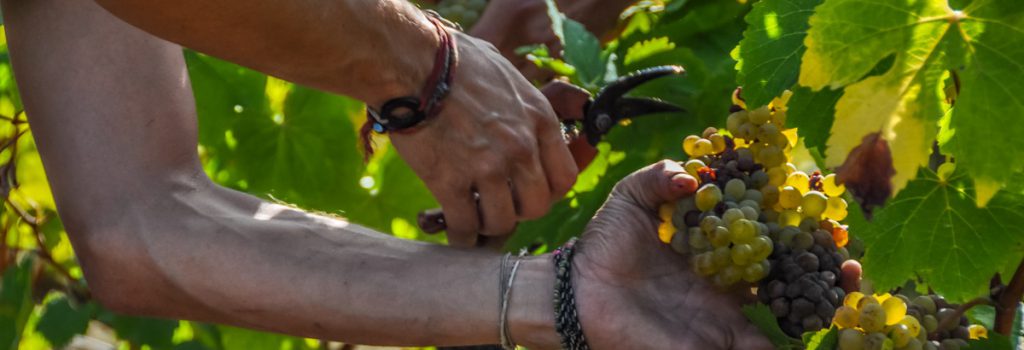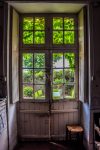Tessa Laroche stands in the fermentation room, surrounded by stainless steel tanks and pours us a glass of the 2015 Domaine aux Moines. The pneumatic press behinds us makes some peculiar sounds. She raises her arms, like a conductor, moves her hands in time with the noise and with a slight bow emphasises the last commotion of the press.
Tessa is the maestro and the wine is her symphony.

As the orchestrator she is, she knows every instrument in her ensemble: the vines, the terroir, the weather, the press, the age of her oak barrels. Every piece is vital for making just the right wine, or to succeed in making a Cuveé – a special vintage.
Her notebooks are scattered across the oak barrels, recently filled with last years’ wine and contain meticulous records of the progress of the harvest, the sweetness of the wine and subsequent alcohol percentage. Nothing is left to chance. You can’t do Beethoven’s Ninth Symphony without, let’s say, the violin. And if one of her instruments are affected by the warm summer and plays a slightly different note, she must know which other instruments to play in order to counteract the dissonance and still make an unforgettable symphony.
And Ode to Joy is, what comes to mind, as we sample the 2014 Domaine aux Moines a bit later by the lunch table. The flavour of this white wine is fresh, mineral and harmonious with notes of oak and elder flower. And the glow of the lazy afternoon sun at harvest time captured in the colours of this amazing wine.
- The vines, the terroir, the weather, the press, the age of the oak barrels. Every piece is vital for making just the right wine, or to succeed in making a Cuveé – a special vintage
- “Ode to Joy” comes to mind, as we sample the 2014 Domaine aux Moines
- Tessa Laroche is the maestro and the wine is her symphony
- “The grapes are sooo good here, you can just eat them directly from the bunch,” he says, grapejuice dripping from the chin to emphasise the remark
- Picking grapes is backbreaking work!
Backbreaking work
The Domaine aux Moines is an organic winery. And that means, that organic farming doesn’t end by the estate’s fence. In fact, the other eight winegrowers of the Savennieres Roche aux Moines appellation have also converted to organic farming. This is essential in keeping the grapes free from pesticides and as natural as possible. Nobody wants their neighbour’s poison on their vines!
Tessa gathers a group of 14 people for the grape harvest. Some are friends, a few are neighbours and others are from abroad, making some backbreaking bucks on this manual labour. The group is divided into pairs and each couple picks a row from either side of the vine. Just like you don’t go diving without a dive-buddy, you don’t go grape picking without a vine-buddy. It takes two set of eyes to locate all the grape clusters hiding in the greenery.
I was teamed up with Delcho, a young Bulgarian earning some cash in the harvest time, travelling through France picking grapes in the different regions, before going back to renovate his cottage in the Bulgarian countryside. “The grapes are sooo good here, you can just eat them directly from the bunch,” he says, grapejuice dripping from the chin to emphasise the remark. “When I picked grapes in another region, they’d been sprayed against pesticides and my skin started itching after a day in the field. I didn’t want to eat those grapes. At all!” he exclaims, looking seriously at me. “Here, the grapes are organic, the labour is done by hand and the wine is natural. Normally, I don’t drink wine, but this wine is the best I’ve ever had.”
- “Here, the grapes are organic, the labour is done by hand and the wine is natural. Normally, I don’t drink wine, but this wine is the best I’ve ever had.”
- Tessa gathers a group of 14 people for the grape harvest. Some are friends, a few are neighbours and others are from abroad
- Every vine especially cared for and handled with love in order to achieve the best yield possible. When you don’t have quantity, you must focus on the quality
- Today, the Domaine aux Moines estate consists of 9,6 hectares of Chenin grapes for Savennieres Roche aux Moines
Pick, eat, drink, sleep, repeat
Delcho is not the only one, that’s in love with Domaine aux Moines. Everybody I talk to agree, that Tessa, the terroir and the soul of this organic winery is quite special. “It’s like family,” some explain, when I ask them, why they volunteer for an aching backside. They come back every year for the event. Work hard during the day and celebrate a Good Day in the evening, toasting on Good Year in last year’s wine. Pick, eat, drink, sleep, repeat. But only for a couple of days, then the harvest of the Chenin Blanc grapes for the Savennieres white wine is over. The harvest of the red Cabernet Franc and Cabernet Sauvignon grapes for the red Anjou Villages is later.
The appellation of Savennieres covers 150 hectares. The cru or sub-appellation Roche aux Moines covers only 33 hectares. Responsible for producing 1/3 of this cru, the Domaine aux Moines is a very boutique vineyard: Not too big, with every vine especially cared for and handled with love in order to achieve the best yield possible. When you don’t have quantity, you must focus on the quality – and that’s what Tessa is accomplishing.
- Pick, eat, drink, sleep, repeat. But only for a couple of days, then the harvest of the Chenin Blanc grapes for the Savennieres white wine is over
- Tessa keeps meticulous records of the progress of the harvest, the sweetness of the wine and subsequent alcohol percentage
- The appellation of Savennieres covers 150 hectares. The cru or sub-appellation Roche aux Moines covers only 33 hectares. Responsible for producing 1/3 of this cru, the Domaine aux Moines is a very boutique vineyard
- “It’s like family,” some explain, when I ask them, why they volunteer for an aching backside
Wine is a feminine, plural word
When the Laroche family bought the Domaine aux Moines estate some 35 years ago, it was mother, Monique Laroche, that began the extensive replanting of the vines and by 1984 had planted 6 more hectares of Chenin Blanc. Today, the estate consists of 9,6 hectares of Chenin grapes for Savennieres Roche aux Moines and 0,8 hectares of Cabernet grapes for Anjou Villages. Monique not only parented a new wine estate, but 3 children as well, one of them which is now continuing the matriarchal tradition. Because Domaine aux Moines is a place, where wine is a feminine, plural word.
Tessa Laroche is a certified oenologist and has worked in other appellations in France, before returning home 15 years ago to her childhood home. Domaine aux Moines is in her blood. And her soul is in Domaine aux Moines.
That’s the deal you make with Bacchus in order to make a good wine.
- Domaine aux Moines is a place, where wine is a feminine, plural word
- Monique Laroche began an extensive replanting of vines and by 1984 had planted 6 more hectares of Chenin Blanc
- Tessa Laroche is a certified oenologist and has worked in other appelations in France, before returning home 15 years ago to her childhood home. Domaine aux Moines is in her blood
- The Laroche family bought the Domaine aux Moines estate some 35 years ago
If you want to know more about French wine and terroir, get a crash course in Burgundian wine, try the crisp bubbles of Alsace, learn about the dark reds of the papal wine from Chateauneuf and tour the warm vineyards and cool cellars of Saumur.
If you’re warming to the idea of backbreaking work and French encounters, check out WWOOF, who propagate seasonal work on organic farms, or ANEFA, the French association for agricultural employment. The latter website is unfortunately in French – but consider it a head start on your French language skills!
Cheers!
Learn more



















